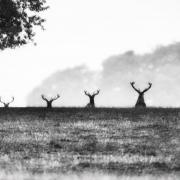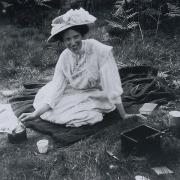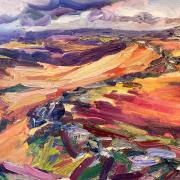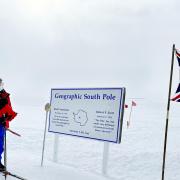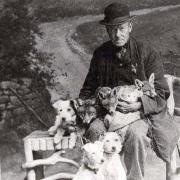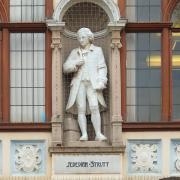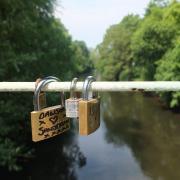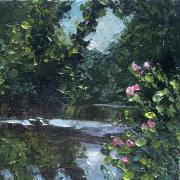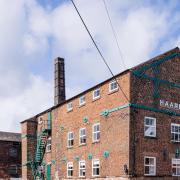It’s been written of the distinguished 18th century physician, polymath, naturalist and poet Erasmus Darwin (1731-1802) that ‘few writers can be so burdened with a surname which so clearly belongs to someone else.’
Though he died seven years before his more famous grandson, the naturalist Charles, was born, Erasmus Darwin anticipated the theory of evolution through natural selection through the medium of poetry.
In his 1803 posthumously published epic poem about the history of the universe, The Temple of Nature (originally titled The Origin of Society) he writes of how:
Organic life beneath the shoreless waves, Was born and nurs’d in Ocean’s pearly caves; First forms minute, unseen by spheric glass, Move on the mud, or pierce the watery mass; These, as successive generations bloom, New powers acquire, and larger limbs assume; Whence countless groups of vegetation spring, And breathing realms of fin and feet and wing.

In The Genius of Erasmus Darwin (2005), biographers CUM Smith and Robert Arnott even described him as ‘the English Leonardo.’
Yet this older Darwin often simply merits a footnote in his famous grandson’s biography. While the younger Darwin provided the practical mechanism for evolution through natural selection in his best-selling On the Origin of Species (1859), it was his grandfather who first anticipated the broad outline of how life developed on earth.
It is well known that Darwin’s works were consulted and commented upon by his grandson Charles Darwin, author of On the Origin of Species.
Erasmus Darwin’s scientific reputation rested on his biological text Zoonomia (1794-96), his radical politics, which encompassed abolitionism and women’s suffrage, and his poetry in The Botanic Garden (1791), where he also popularised Carl Linnaeus’s system of biological classification.
But Zoonomia is considered his most important scientific work, containing a chapter on ‘Generation’.
In this, he anticipated some of the views of Jean-Baptiste Lamarck, which also foreshadowed the modern theory of evolution.
The essence of the older Darwin’s views is contained in the following passage from Zoonomia, in which he concluded the same kind of living filament is, and always has been, the cause of all organic life:
‘Would it be too bold to imagine, that in the great length of time, since the earth began to exist, perhaps millions of ages before the commencement of the history of mankind, would it be too bold to imagine, that all warm-blooded animals have arisen from one living filament, which THE GREAT FIRST CAUSE endued with animality, with the power of acquiring new parts, attended with new propensities, directed by irritations, sensations, volitions, and associations; and thus possessing the faculty of continuing to improve by its own inherent activity, and of delivering down those improvements by generation to its posterity, world without end!’
Darwin also anticipated the theory of the survival of the fittest in Zoonomia in his views on how a species should reproduce itself.
His idea was that ‘the strongest and most active animal should propagate the species, which should thence become improved.’ Today, this is known as the survival of the fittest, and often credited to his grandson, Charles.

But it was perhaps The Temple of Nature which was his masterpiece. His biographer Desmond King-Hele claimed his was the ‘greatest imaginative construct in the history of the world, because he was the first person to arrive at and fully express and expound a nearly correct view of the development of life on Earth.’
The Temple of Nature is prophetic, even depicting the so-called Big Bang theory of the evolution of the universe billions of years ago, and that of organic life arising from the primordial soup.
Both Darwin’s long poems were written with the aim ‘to enlist imagination under the banner of science’, making him one of the earliest poets to take science as his subject.
Erasmus Darwin, originally a provincial physician, became one of the key thinkers of the Midlands Enlightenment.
As a member of the Darwin–Wedgwood family, which included grandsons Charles Darwin and Francis Galton, Darwin was the moving spirit behind the Lunar Society of Birmingham.
This was a discussion group of pioneering industrialists and natural philosophers, including James Watt and Matthew Boulton, who took their name because they met monthly by the light of the full moon.
Darwin was born in 1731 at Elston Hall, near Newark-on-Trent in Nottinghamshire, the youngest of seven children of Robert Darwin, a lawyer and physician, and his wife Elizabeth Hill.
He was educated at Chesterfield Grammar School, then later at St John's College, Cambridge. He obtained his medical education at the University of Edinburgh Medical School.
Darwin settled in Nottingham as a physician in 1756 but, met with limited success, moved the following year to Lichfield to establish a practice there. He was a highly successful physician for more than 50 years in the Midlands and George III invited him to be Royal Physician, but he declined.
It was at Lichfield that Darwin started to write his poetry, developed his theory of evolution, and invented among other things, a carriage steering mechanism, a manuscript copier and a speaking machine.
He is known to have visited the Castleton caves at this time and recorded his impressions: ‘I have been into the Bowels of old Mother Earth, and seen Wonders and learnt much curious knowledge in the Regions of Darkness…’
In 1757 he married Mary (Polly) Howard, daughter of a Lichfield solicitor. They had four sons and one daughter, including Robert Waring Darwin (1766–1848), father of the naturalist Charles Darwin.
His first wife died in 1770 and a governess, Mary Parker, was hired to look after Robert. By late 1771, Darwin and Parker had become intimately involved and had two illegitimate daughters, Susanna and Mary. Darwin later set up ‘Miss Parker’s School’ in Ashbourne, for his two daughters.
In 1775 Darwin met Elizabeth Pole, daughter of Charles Colyear, 2nd Earl of Portmore, and wife of Colonel Edward Pole, but as she was married, Darwin could only make his feelings known through his poetry.
When Edward Pole died, Darwin married Elizabeth and moved to her home at Radbourne Hall, four miles west of Derby. In 1782, they moved to Full Street, Derby, and had four sons, one of whom died in infancy, and three daughters.
Darwin’s personal appearance was described in somewhat unflattering detail in Biographical Memoirs, published in 1802.
Darwin, the description reads, ‘was of middle stature, in person gross and corpulent; his features were coarse, and his countenance heavy; if not wholly void of animation, it certainly was by no means expressive. The print of him, from a painting of Mr. (Joseph) Wright, is a good likeness. In his gait and dress he was rather clumsy and slovenly, and frequently walked with his tongue hanging out of his mouth.’
Darwin died suddenly in April 1802, weeks after moving to Breadsall Priory, just north of Derby, and was buried in All Saints’ Church, Breadsall.
Today, there is an Erasmus Darwin Museum in his former family home at Darwin House, in Cathedral Close, Lichfield, and an Erasmus Darwin Academy at Burntwood in Staffordshire.
Darwin’s poetry was admired by contemporaries such as William Wordsworth, but not everyone was enamoured by it. Samuel Taylor Coleridge was stingingly critical, writing: ‘I absolutely nauseate Darwin’s poem.’




